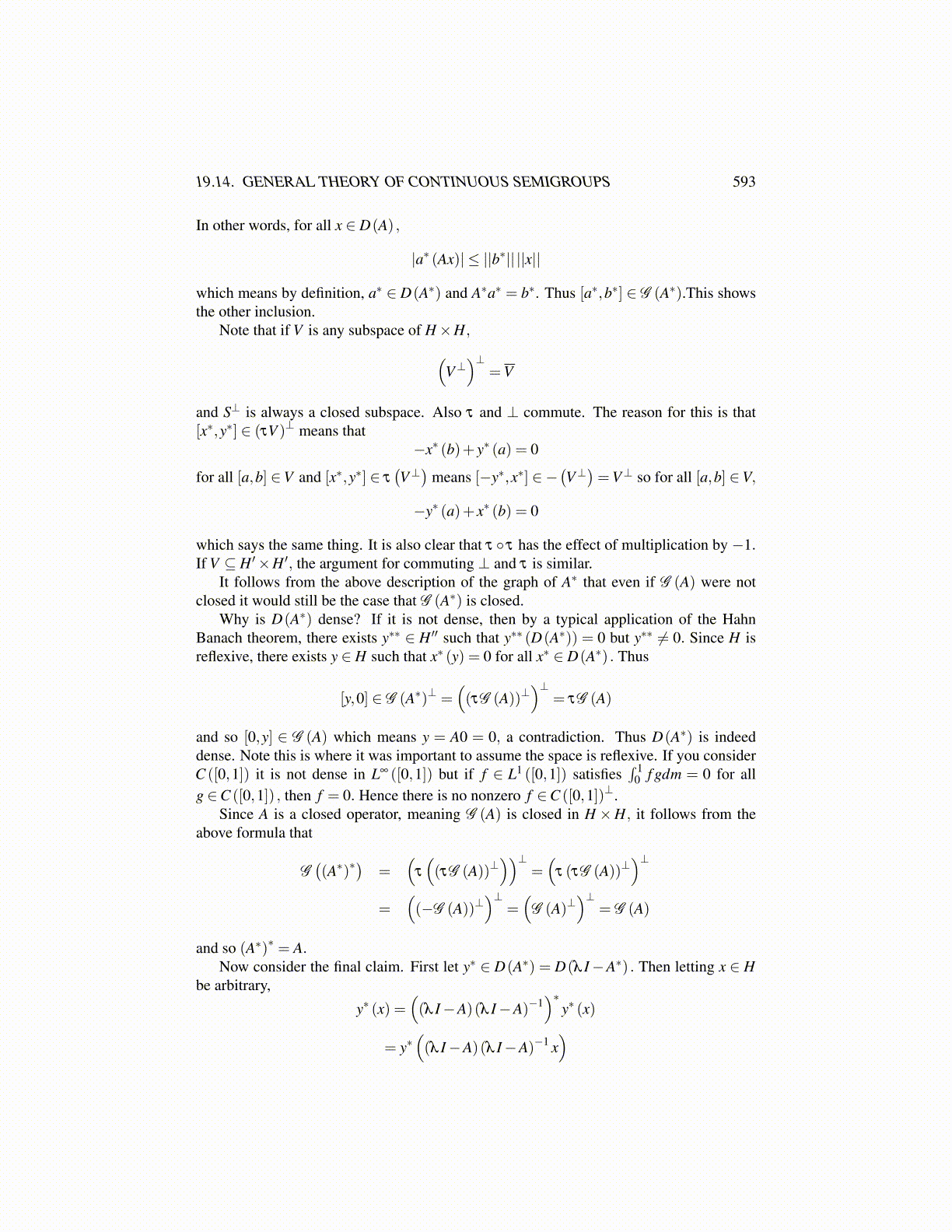
19.14. GENERAL THEORY OF CONTINUOUS SEMIGROUPS 593
In other words, for all x ∈ D(A) ,
|a∗ (Ax)| ≤ ||b∗|| ||x||
which means by definition, a∗ ∈ D(A∗) and A∗a∗ = b∗. Thus [a∗,b∗] ∈ G (A∗).This showsthe other inclusion.
Note that if V is any subspace of H×H,(V⊥)⊥
=V
and S⊥ is always a closed subspace. Also τ and ⊥ commute. The reason for this is that[x∗,y∗] ∈ (τV )⊥ means that
−x∗ (b)+ y∗ (a) = 0
for all [a,b] ∈V and [x∗,y∗] ∈ τ(V⊥)
means [−y∗,x∗] ∈ −(V⊥)=V⊥ so for all [a,b] ∈V,
−y∗ (a)+ x∗ (b) = 0
which says the same thing. It is also clear that τ ◦ τ has the effect of multiplication by −1.If V ⊆ H ′×H ′, the argument for commuting ⊥ and τ is similar.
It follows from the above description of the graph of A∗ that even if G (A) were notclosed it would still be the case that G (A∗) is closed.
Why is D(A∗) dense? If it is not dense, then by a typical application of the HahnBanach theorem, there exists y∗∗ ∈ H ′′ such that y∗∗ (D(A∗)) = 0 but y∗∗ ̸= 0. Since H isreflexive, there exists y ∈ H such that x∗ (y) = 0 for all x∗ ∈ D(A∗) . Thus
[y,0] ∈ G (A∗)⊥ =((τG (A))⊥
)⊥= τG (A)
and so [0,y] ∈ G (A) which means y = A0 = 0, a contradiction. Thus D(A∗) is indeeddense. Note this is where it was important to assume the space is reflexive. If you considerC ([0,1]) it is not dense in L∞ ([0,1]) but if f ∈ L1 ([0,1]) satisfies
∫ 10 f gdm = 0 for all
g ∈C ([0,1]) , then f = 0. Hence there is no nonzero f ∈C ([0,1])⊥.Since A is a closed operator, meaning G (A) is closed in H ×H, it follows from the
above formula that
G((A∗)∗
)=
(τ
((τG (A))⊥
))⊥=(
τ (τG (A))⊥)⊥
=((−G (A))⊥
)⊥=(G (A)⊥
)⊥= G (A)
and so (A∗)∗ = A.Now consider the final claim. First let y∗ ∈ D(A∗) = D(λ I−A∗) . Then letting x ∈ H
be arbitrary,
y∗ (x) =((λ I−A)(λ I−A)−1
)∗y∗ (x)
= y∗((λ I−A)(λ I−A)−1 x
)